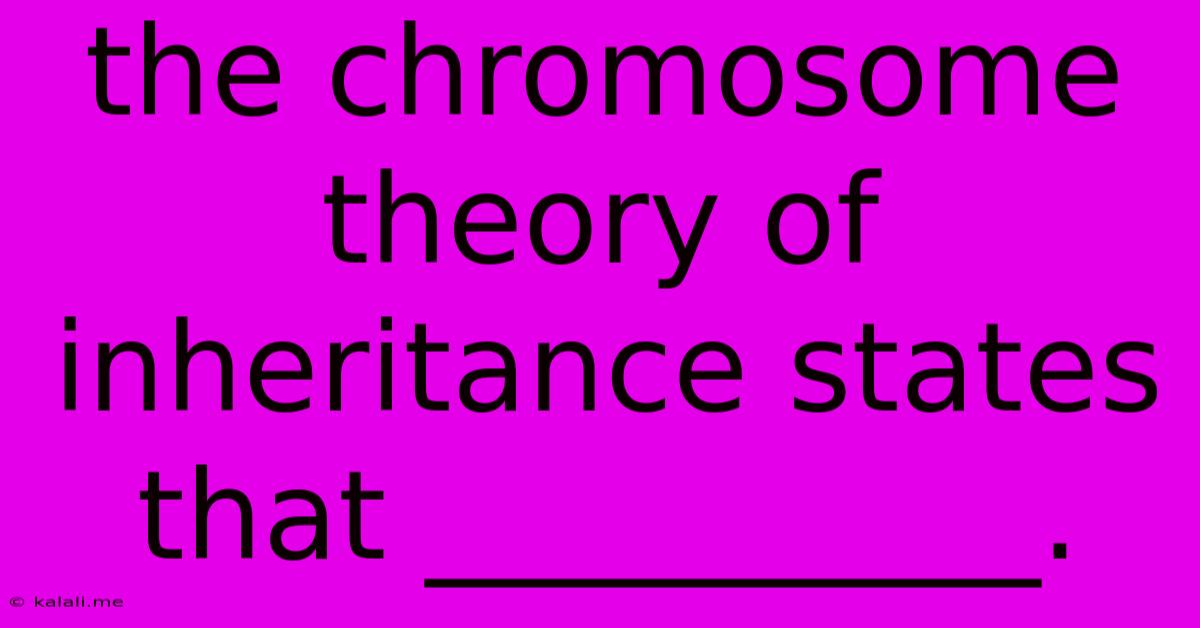The Chromosome Theory Of Inheritance States That __________.
Kalali
Jun 13, 2025 · 3 min read

Table of Contents
The Chromosome Theory of Inheritance: Genes Ride the Chromosomes
The chromosome theory of inheritance states that genes are located on chromosomes, and it is the chromosomes that segregate and assort independently during meiosis, resulting in the inheritance patterns observed by Mendel and others. This seemingly simple statement revolutionized our understanding of heredity, bridging the gap between Mendel's abstract "factors" and the observable structures within cells. Understanding this theory is fundamental to grasping modern genetics.
This article will delve into the key tenets of the chromosome theory, exploring its historical context, supporting evidence, and its continuing impact on biological research.
A Historical Perspective: From Mendel's Factors to Chromosomal Location
Gregor Mendel's groundbreaking work in the mid-1800s established the basic principles of inheritance: segregation and independent assortment. However, the physical basis of these principles remained a mystery. The discovery of chromosomes and their behavior during cell division provided the crucial missing piece.
Scientists like Walter Sutton and Theodor Boveri, independently working at the turn of the 20th century, observed striking parallels between the behavior of chromosomes during meiosis and Mendel's laws. They noted that:
- Chromosomes occur in pairs: Just as Mendel's factors existed in pairs, chromosomes exist in homologous pairs, one inherited from each parent.
- Chromosomes segregate during meiosis: Homologous chromosomes separate during meiosis I, mirroring Mendel's law of segregation, where alleles separate into different gametes.
- Chromosomes assort independently: Non-homologous chromosomes assort independently during meiosis I, aligning with Mendel's law of independent assortment, explaining the inheritance of multiple traits.
These observations led to the formulation of the chromosome theory of inheritance, establishing chromosomes as the carriers of Mendel's hereditary factors – later termed genes.
Evidence Supporting the Chromosome Theory
Several pieces of evidence solidified the chromosome theory:
- Sex-linked inheritance: The discovery of sex-linked traits, like hemophilia and color blindness, provided strong support. These traits are inherited differently in males and females, directly correlating with the presence of sex chromosomes (X and Y).
- Chromosome mapping: The ability to map the location of genes on chromosomes further confirmed their linkage. Genetic linkage – the tendency for genes located close together on the same chromosome to be inherited together – is a direct consequence of their physical proximity.
- Cytogenetics: The study of chromosomes using microscopy techniques revealed visible changes in chromosomes associated with genetic abnormalities, such as Down syndrome (trisomy 21). This demonstrated a direct link between chromosomal structure and inherited traits.
- Molecular genetics: The discovery of DNA as the genetic material and its location within chromosomes provided the ultimate confirmation of the theory. The sequence of DNA within genes dictates the synthesis of proteins, connecting genotype to phenotype.
Exceptions and Refinements
While the chromosome theory provides a powerful framework for understanding inheritance, it's important to acknowledge some exceptions and refinements:
- Linkage and crossing over: While genes on the same chromosome tend to be inherited together, crossing over during meiosis can shuffle alleles, leading to recombination and breaking up linked genes.
- Gene interactions: The expression of a gene can be influenced by other genes, leading to complex inheritance patterns beyond simple Mendelian ratios.
- Non-nuclear inheritance: Some genes are located outside the nucleus, in mitochondria or chloroplasts, exhibiting non-Mendelian inheritance patterns.
The Enduring Legacy
The chromosome theory of inheritance remains a cornerstone of modern genetics. Its principles underpin our understanding of genetic diseases, genetic engineering, and evolutionary processes. Its development marked a pivotal moment in biology, showcasing the power of connecting abstract principles with observable structures, a testament to the scientific method's ability to unravel the complexities of life. The theory continues to evolve, refined by ongoing research into genome structure, gene regulation, and epigenetic mechanisms. Its legacy ensures its continued importance in the field of genetics.
Latest Posts
Latest Posts
-
Does Hawaii Pacific University Require Sat
Jun 14, 2025
-
Which Of The Following Is The Inverse Of
Jun 14, 2025
-
How To Find Midpoint Of Triangle
Jun 14, 2025
-
Which Of The Following Is Not A Long Term Storage Device
Jun 14, 2025
-
Cutoff Frequency Of High Pass Filter Formula
Jun 14, 2025
Related Post
Thank you for visiting our website which covers about The Chromosome Theory Of Inheritance States That __________. . We hope the information provided has been useful to you. Feel free to contact us if you have any questions or need further assistance. See you next time and don't miss to bookmark.